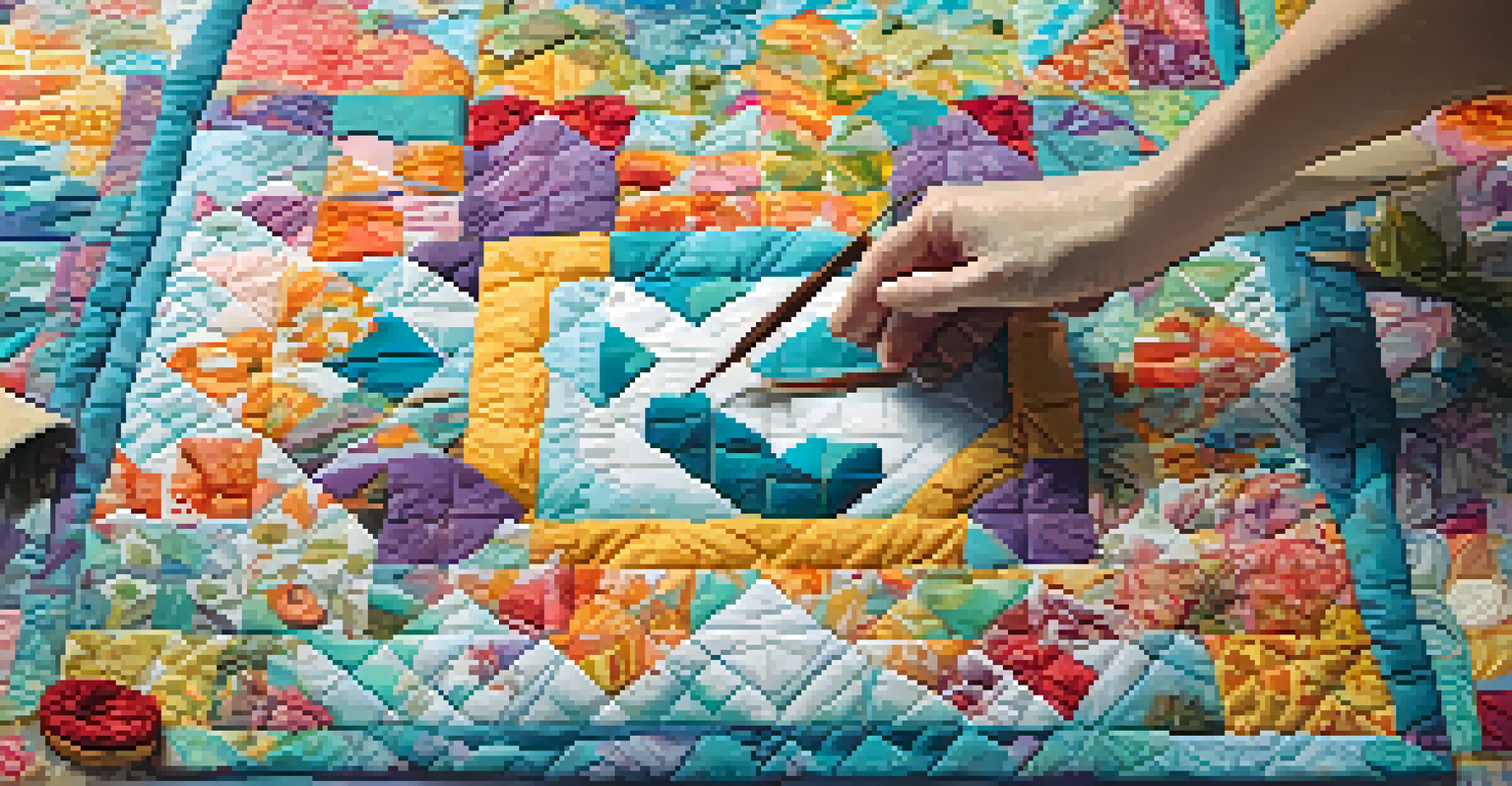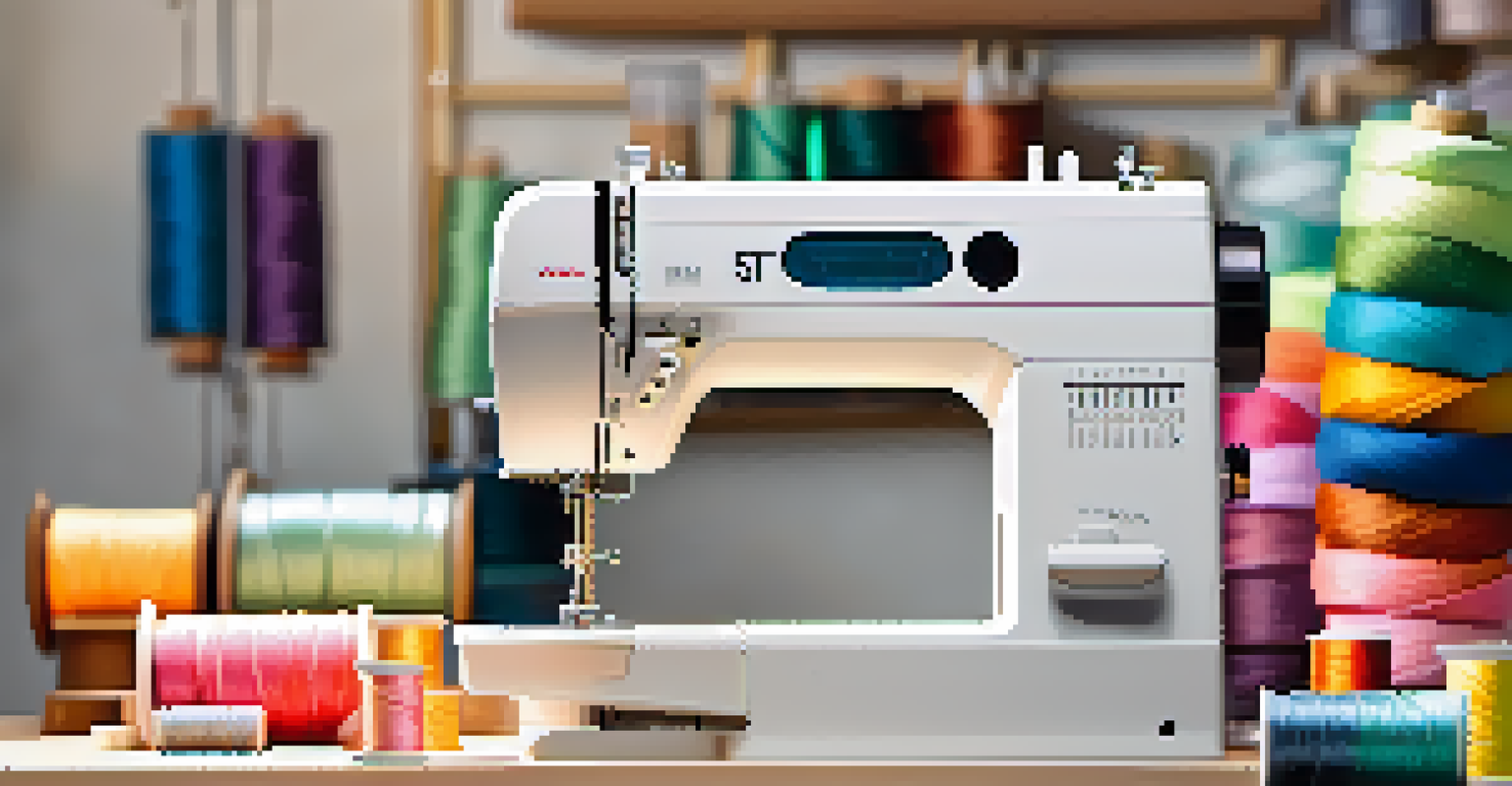Quilting Techniques: Machine vs. Hand Quilting Explained

Understanding Quilting: What is it Exactly?
Quilting is the art of stitching together layers of fabric to create a warm and decorative piece. Traditionally, quilts are made of three layers: the top, the batting (the middle layer for warmth), and the backing. This process not only provides insulation but also allows for incredible creativity in design and patterns. Whether it's for a cozy bedspread or a decorative wall hanging, quilting is a versatile craft enjoyed by many.
Quilting is the perfect blend of creativity and functionality, allowing us to express ourselves while creating something useful.
The beauty of quilting lies in its ability to blend artistry with functionality. From vibrant patchwork designs to intricate motifs, each quilt tells a story, often reflecting the personality of the quilter. Quilting can be a form of personal expression, with each stitch representing time and care. As we delve deeper into the techniques, it's essential to appreciate how this craft has evolved.
In the quilting world, two primary techniques stand out: machine quilting and hand quilting. Each method has its unique advantages and challenges, appealing to different preferences and skill levels. Understanding these techniques can help you choose the best approach for your next project, whether you're a seasoned quilter or just starting.
Hand Quilting: The Traditional Approach
Hand quilting is the age-old method of stitching quilts by hand, using a needle and thread to bind the layers together. This technique demands patience and a steady hand, often resulting in intricate designs that showcase the quilter’s skill. Many enthusiasts cherish the tactile experience of hand quilting, finding it meditative and rewarding as each stitch is made with intention.

The beauty of hand quilting lies in its detail. Quilters can create stunning patterns and textures, often using various stitches to enhance the visual appeal. This technique allows for greater flexibility in design, as quilters can adjust their patterns as they sew. Additionally, hand quilting often produces a softer finish, as the stitches are typically less dense than machine quilting.
Quilting Combines Art and Function
Quilting merges creativity with practicality, allowing quilters to express their personality while creating warm and decorative pieces.
However, hand quilting can be time-consuming and physically demanding, which may deter some quilters. It may take weeks or even months to complete a quilt, depending on its size and complexity. Yet, for those who appreciate the artistry and tradition of quilting, the final product is often worth the investment of time and effort.
Machine Quilting: Efficiency and Precision
Machine quilting, on the other hand, harnesses the power of sewing machines to stitch quilts quickly and efficiently. This method is ideal for those looking to complete projects in a shorter timeframe, making it a popular choice for busy crafters. With advancements in technology, modern sewing machines come equipped with various features that enhance precision and ease, such as walking feet and automatic stitch settings.
Every quilt tells a story, each stitch a chapter, reflecting the care and time invested into its making.
One of the significant advantages of machine quilting is its ability to produce uniform stitches consistently. This consistency not only speeds up the process but also allows for more intricate designs that might be challenging to achieve by hand. Many quilters appreciate the ability to create complex patterns without the physical strain that hand quilting can entail.
However, machine quilting may lack the personal touch that hand-quilted pieces often possess. While it allows for speed and efficiency, some quilters feel that the machine's mechanical nature can make the finished product feel less intimate. Nevertheless, for those who prioritize time and precision, machine quilting can be an excellent choice, especially for larger projects.
Comparing the Two Techniques: Pros and Cons
When comparing hand quilting and machine quilting, it's essential to consider the pros and cons of each method. Hand quilting is celebrated for its artistry and personal touch, allowing for unique designs and textures. However, the time commitment involved can be a significant drawback for those with busy schedules.
On the flip side, machine quilting offers efficiency and uniformity, making it easier to complete larger projects in less time. The downside is that some may feel it lacks the warmth and personal connection that comes from hand-stitched quilts. Ultimately, the choice between the two often boils down to personal preference and the specific goals of the quilting project.
Hand vs. Machine Quilting Techniques
Hand quilting offers a personal touch and intricate designs, while machine quilting provides speed and efficiency for larger projects.
Many quilters find joy in exploring both techniques, utilizing hand quilting for special, sentimental pieces while opting for machine quilting for more practical projects. This versatility allows quilters to enjoy the best of both worlds, making their quilting journey even more fulfilling.
Choosing the Right Technique for You
Deciding whether to hand quilt or machine quilt depends on various factors, such as your available time, budget, and personal preferences. If you have a deep appreciation for craftsmanship and are willing to invest time, hand quilting might be your calling. It's a wonderful way to slow down and immerse yourself in the art, creating pieces with a unique story.
Conversely, if you're looking for a quicker turnaround or are planning to tackle larger projects, machine quilting might be more suitable. Many quilters enjoy the convenience of using a sewing machine to complete pieces without sacrificing quality. Plus, as you become more comfortable with the machine, you'll find ways to express your creativity through intricate designs.
Ultimately, the best technique is the one that resonates with you. Whether you choose the traditional route of hand quilting or the modern approach of machine quilting, each method offers its own set of rewards and challenges. Embrace the journey, and remember that the most important aspect of quilting is the joy it brings you.
Essential Tools for Hand Quilting
If you decide to embark on the hand quilting journey, having the right tools can significantly enhance your experience. Essential tools include a good quality needle, thread, scissors, and a thimble for protecting your fingers. Additionally, a hoop or frame can help keep your fabric taut, making it easier to stitch accurately.
Selecting the right type of thread is also crucial; many quilters prefer cotton thread for its durability and ease of use. You might also want to explore different needle sizes to find what feels comfortable for your stitching. Investing in high-quality materials can make your hand quilting experience more enjoyable and yield better results.
Choosing the Right Quilting Method
Selecting between hand and machine quilting depends on your available time, budget, and personal preferences, making each method uniquely rewarding.
Finally, don't underestimate the importance of a comfortable workspace. Ensure you have good lighting and a supportive chair to minimize strain during long quilting sessions. With the right tools and environment, hand quilting can transform from a challenging task into a delightful creative outlet.
Key Tools for Successful Machine Quilting
When it comes to machine quilting, having the right equipment can make all the difference. Start with a reliable sewing machine that can handle multiple layers of fabric, as well as a walking foot or quilting foot to help guide your stitches evenly. These attachments are designed specifically for quilting and can greatly improve your stitching accuracy.
In addition to the machine, choosing the right type of thread is essential. Many quilters prefer polyester or cotton thread, as they provide strength without compromising flexibility. It's also beneficial to have a variety of needle sizes on hand, enabling you to select the appropriate one for different fabric thicknesses.

Finally, a well-organized workspace can enhance your machine quilting experience. Ensure your setup allows for easy movement of fabric and has ample lighting to reduce eye strain. With the proper tools and a comfortable environment, machine quilting can become a highly enjoyable and efficient endeavor.
Final Thoughts: Embracing Your Quilting Journey
Quilting, whether by hand or machine, is a beautiful craft that invites creativity and personal expression. As you explore the techniques, it's essential to remember that the journey is just as important as the final product. Each stitch, whether made by hand or machine, contributes to a unique story that you can cherish.
Don't be afraid to experiment with both methods to find what truly resonates with you. Each technique has its strengths and challenges, and discovering what you enjoy most can be a rewarding part of your quilting journey. Plus, mixing techniques can yield fascinating results and broaden your skillset.
Ultimately, quilting is about creating something meaningful and enjoying the process. Whether you choose to hand stitch a beloved family heirloom or machine quilt a practical everyday piece, embrace the art of quilting with open arms. Happy quilting!